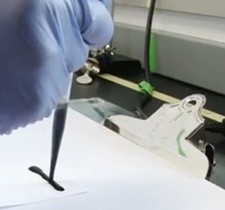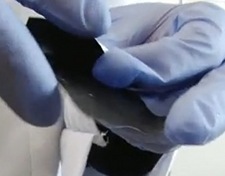Nanotech ink turns paper into batteries
Dec 11, 2009 — by LinuxDevices Staff — from the LinuxDevices Archive — viewsStanford University researchers have demonstrated a way to turn ordinary paper into a battery, which may be crumpled or pressed into any form. It's said the low-cost technology promises greater durability, higher efficiency, and faster energy transfer than traditional batteries.
The development was reported this week in a paper, "Highly Conductive Paper for Energy Storage Devices," published online in the Proceedings of the National Academy of Sciences. The team, led by Yi Cui, assistant professor of materials science and engineering at Stanford, reports taking ordinary paper intended for a Xerox machine, then coating it (below left) with special ink made of carbon nanotubes and silver nanowires. Once this is done, the paper is baked, and then becomes a highly conductive storage device (below right), the researchers say.


Nanomaterial ink is painted onto ordinary paper, which is then baked
"These nanomaterials are special," Cui is quoted as saying in a Stanford Report article by writer Janelle Weaver. "They're a one-dimensional structure with very small diameters."
Thanks to these small diameters, it's said, the nanomaterial ink sticks strongly to the fibrous paper, allowing the battery to be extremely durable. The paper battery could last through 40,000 charge-discharge cycles — at least an order of magnitude more than lithium batteries. The nanomaterials also make ideal conductors because they move electricity along much more efficiently than ordinary materials, Cui is reported as saying.
According to Weaver, the paper batteries may be crumpled or folded, or even soaked in acidic or basic solutions, and their performance does not degrade. "We just haven't tested what happens when you burn it," Cui is said to have quipped.

Wrapped in foil shielding, the paper battery is shown powering a light bulb
Paper batteries will also have a high surface-to-volume ratio, allowing for quick energy transfer, according to the researchers. Therefore, the technology can be used not only for batteries, but also for supercapacitors, storing and discharging energy much more rapidly than batteries do. Thus, Hansen's article suggests, conductive paper may be particularly useful in applications such as electric or hybrid cars.
"This technology has [the] potential to be commercialized within a short time," Peidong Yang, professor of chemistry at UC Berkeley is quoted as saying. "I don't think it will be limited to just energy storage devices. This is potentially a very nice, low-cost, flexible electrode for any electrical device."
Creation and use of paper batteries
Source: Stanford University News Service
(click to play)
Janelle Hansen's Stanford Report article on the newly developed paper batteries may be found on the Stanford website, here.
The research paper, "Highly Conductive Paper for Energy Storage Devices," may be downloaded from the Proceedings of the National Academy of Sciences website, here [PDF format; $10 fee required].
This article was originally published on LinuxDevices.com and has been donated to the open source community by QuinStreet Inc. Please visit LinuxToday.com for up-to-date news and articles about Linux and open source.